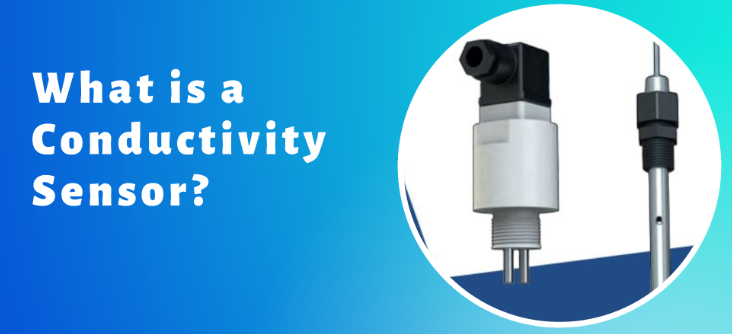
A conductivity sensor, also known as a conductivity probe or conductivity meter, is an instrument used to measure the electrical conductivity of a solution. Conductivity is a measure of a solution's ability to conduct an electric current, which depends on the concentration of ions and other charged particles in the solution.
The conductivity sensor typically consists of two or more electrodes that are immersed in the solution being tested. An electrical current is passed between the electrodes, and the sensor measures the resistance or conductance of the solution to the current flow. Conductivity is usually reported in units of Siemens per centimeter (S/cm) or microsiemens per centimeter (μS/cm).
Applications of Conductivity Sensor
Conductivity sensors are commonly used in various applications, including:
Water quality monitoring:
Conductivity measurements are used to assess the salinity and total dissolved solids (TDS) in water bodies, such as rivers, lakes, and oceans. Changes in conductivity can indicate pollution, contamination, or changes in water composition.
Industrial processes:
Conductivity sensors are utilized in industries like chemical manufacturing, pharmaceuticals, food and beverage, and water treatment. They help monitor and control the concentration of dissolved substances, detect leaks, and ensure product quality.
Agriculture and hydroponics:
Conductivity measurements assist in monitoring the nutrient levels in soil and hydroponic solutions, helping farmers optimize plant growth and prevent nutrient imbalances.
Scientific research:
Conductivity sensors are used in laboratories for various scientific experiments, including studying the properties of electrolytes, monitoring chemical reactions, and analyzing biological samples.
Features of a Conductivity Sensor
Conductivity sensors come with various features depending on their specific design and intended application. Here are some common features you may find in conductivity sensors:
Measurement Range:
Conductivity sensors have a specific measurement range within which they can accurately measure conductivity. The range can vary from low conductivity values (e.g., microsiemens per centimeter) to high conductivity values (e.g., millisiemens per centimeter). The sensor's range should be suitable for the conductivity levels expected in the target application.
Temperature Compensation:
Many conductivity sensors incorporate temperature compensation capabilities. Since conductivity is affected by temperature, these sensors measure and compensate for temperature variations to provide accurate readings. Temperature compensation ensures that the conductivity measurements are standardized and consistent regardless of temperature fluctuations.
Cell Constant:
The cell constant of a conductivity sensor refers to its geometric factor, which relates the electrode spacing and geometry to the measured conductivity. Different sensors may have different cell constants, which are important for converting the measured electrical conductance to actual conductivity values. The cell constant is typically specified by the manufacturer and may be adjustable or fixed.
Material and Construction:
Conductivity sensors are available in various materials and designs to suit different applications. The sensor's construction should be compatible with the sample being measured, ensuring resistance to corrosion, chemical attack, and fouling. Common materials used for sensor electrodes include stainless steel, platinum, graphite, or glassy carbon.
Calibration:
Conductivity sensors require periodic calibration to maintain accuracy. Calibration involves adjusting the sensor's measurements against known standard solutions with known conductivity values. Some sensors may offer automatic or manual calibration options, and the calibration data may be stored in the sensor or an associated device for reference.
Connectivity and Data Logging:
Advanced conductivity sensors may include built-in data logging capabilities and connectivity options. They can store measurement data internally or transmit it to external devices or systems via wired or wireless connections. This feature enables real-time monitoring, data analysis, and integration with control systems or data management platforms.
Sensor Maintenance:
Depending on the design, conductivity sensors may require regular maintenance, such as cleaning, electrode replacement, or recalibration. Sensor manufacturers typically provide guidelines and recommendations for proper maintenance procedures to ensure accurate and reliable measurements.
It's important to note that the specific features and capabilities of conductivity sensors may vary among different manufacturers and models. Therefore, it's essential to consult the sensor's documentation or contact the manufacturer for detailed information on the features offered by a particular conductivity sensor.
Conductivity sensors can be standalone devices or integrated into larger systems or instruments. They provide a quick and reliable method for assessing the ionic content and purity of solutions in a wide range of applications.
About Petron Thermoplast
Petron Thermoplast is proud to offer a range of high-quality conductivity sensors that excel in accuracy and performance. Our Conductivity Sensors are designed with precision and reliability in mind, making them ideal for a wide range of applications across industries.
One of the key features of our Conductivity Sensors is their exceptional measurement accuracy. With advanced technology and meticulous calibration, our sensors provide precise and consistent conductivity readings, ensuring reliable data for critical processes and analysis. You can trust our sensors to deliver accurate results even in demanding and dynamic environments.























